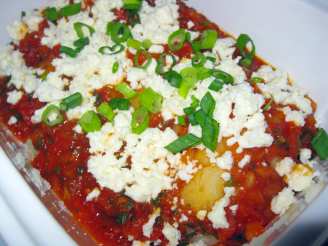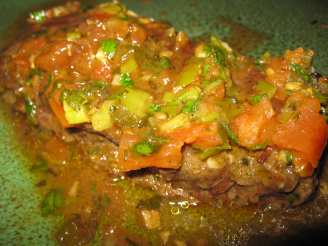Chorizo - Colombian Style

photo by Fabio


- Ready In:
- 48hrs 20mins
- Ingredients:
- 11
- Serves:
-
30
ingredients
- hog casing, 1 1/4 inch (Approximately 50 feet)
- 59.16 ml cider vinegar (for soaking the hog casings)
- 3175.14 g lean pork (I use Boston butt)
- 1360.77 g pork belly (I have also used smoked hog jowls)
- 6 garlic cloves (minced finely)
- 4 bunch green onions (chopped finely)
- 1 bunch fresh cilantro (chopped finely, stems and all)
- 14.79 ml dried oregano (chopped, not powdered)
- 29.58 ml white vinegar (I have also used lemon juice)
- 828.06 ml cold water (approximately)
- 103.53 ml salt (I really prefer Kosher salt)
directions
-
The casings:
- 1. Soak the hog casings in 4 cups tepid water (90 degrees to start) overnight in the fridge. Some sausage experts may disagree but I soak the casings overnight and then, prior to stuffing them, I add about 1 tablespoon of cider vinegar per cup of water (4 tbs. in this case) and let the casings soak for the final 15 minutes. I have found that the vinegar makes the casings more pliable and translucent.
- 2. Rinse the casings thoroughly inside and out (simply slide the end of the casing over your faucet and run water through). Begin stuffing right away since the casings may become tough or burst if you let them dry too much.
-
The stuffing:
- 1. Cut the pork meat and the pork belly into very small cubes (approximately ¼ inch). This is the longest and most tiring part but don’t be lazy; the more uniform your cubes are, the better the mixture will blend and the more evenly your chorizo will cook. Please, do not grind the meat!
- 2. Put the cubed meat in a large bowl and mix it well.
- 3. Add the finely chopped cilantro and green onions and mix well.
- 4. Add the rest of the ingredients (minced garlic, oregano, salt and vinegar). Mix well with your hands.
- 5. Finally, start adding the water gradually and mixing it with your hands. I normally add two cups, mix it and then add more water until the mixture becomes sticky but not runny. Continue to hand-mix for approximately ten minutes to make sure that the water is fully incorporated into the mixture.
- 6. This is where some other experts may also disagree but I let the stuffing mixture sit in the fridge overnight, covered. I honestly think that this allows all of the flavors to really soak into the meats and bring out the unique Colombian flavor in the chorizos.
- 7. Tie one end of the casing in a knot. I don’t like to use thread because it gets stuck between my teeth. Stuff the casings and tie the other end. To make the links, I simply twist the stuffed casing two or three times every six inches or so (up to you on the link length). Stuffing is one of those trial-and-error kinds of things. Too tight and you may burst the casing as you twist it into links; too loose and your chorizo will get all wrinkly and have air pockets all over the place. I usually stuff one end of the casing fairly full and then very lightly at the other end. This way, I can start twisting from the heavy end, twist and allow the mixture to move along the length of the casing and fill in the light end. (Boy, I hope that made sense!).
- 8. After the links are done, use a pin or needle to poke three or four holes on each side of the link. This prevents bursting while cooking.
- 9. The final step is yet one more with which the experts may disagree. However, I most assuredly remember that all of the restaurants I visited as a child that served chorizo, cured the links for approximately three days. My “curing” consists simply of hanging the chorizos as horizontally as possible from hooks around the bay window frame in my butler pantry. If you decide to cure them, make sure that you place paper towels or newspaper on the sill to catch the drippings. Allowing the chorizos to dangle vertically will probably result in the twisted links unraveling somewhat.
- 10. Storage: My family loves chorizos so I really do not have to worry too much about storage. However, on the couple of occasions where I had to store a few links, they will keep perfectly in the refrigerator for up to 20 days. I have also frozen some of them and have had no problems thawing them out and using them normally.
-
Cooking:
- 1. My favorite cooking method is to put the links in a frying pan with enough water to reach about half way up the prone link. Turn your burner to low and allow the chorizo to cook slowly until all the water has evaporated, turning occasionally so all sides cook evenly. After the water has evaporated, the chorizo will look kind of whitish and opaque. Continue to fry until dark brown. The fat from the chorizo mixture will escape through the pin holes and will provide enough of a frying medium so that you do not have to add oil or any other frying agent.
- 2. Other methods include cooking them over charcoal, on your gas grill, boiled, skewered over a wood fire and, of course, cut into chunks as part of lentil soup and other dishes. Whatever method you choose, remember that chorizo should be cooked slowly and gently to avoid bursting the casings. Please come back in the future as I plan to soon upload my recipe for “sancocho” which, of course, includes lots of chorizo.
Reviews
-
Just finished mixing a batch to try out these "Colombian" chorizos. Used kosher salt as recommended, which has a less intense taste than table salt. Still, this is impossibly salty - and I love salt. I would use 7 teaspoons kosher salt instead of 7 tablespoons - one third as much. No cumin, no black pepper, no Cayenne pepper, none of the condiments I would have associated with "Colombian". No good.
RECIPE SUBMITTED BY
Fabio
Brookline Station
Just a guy from Colombia who loves to cook, make my own beer, my own sausage and play with my grandchildren.



